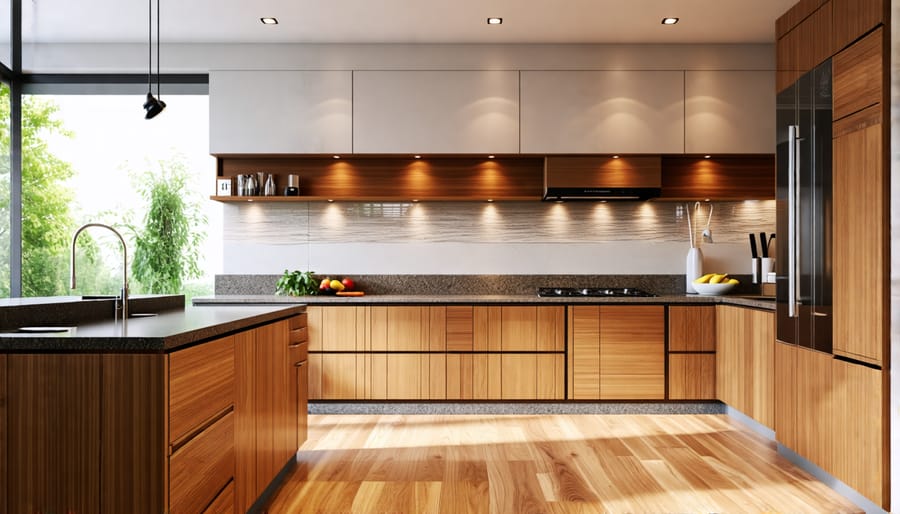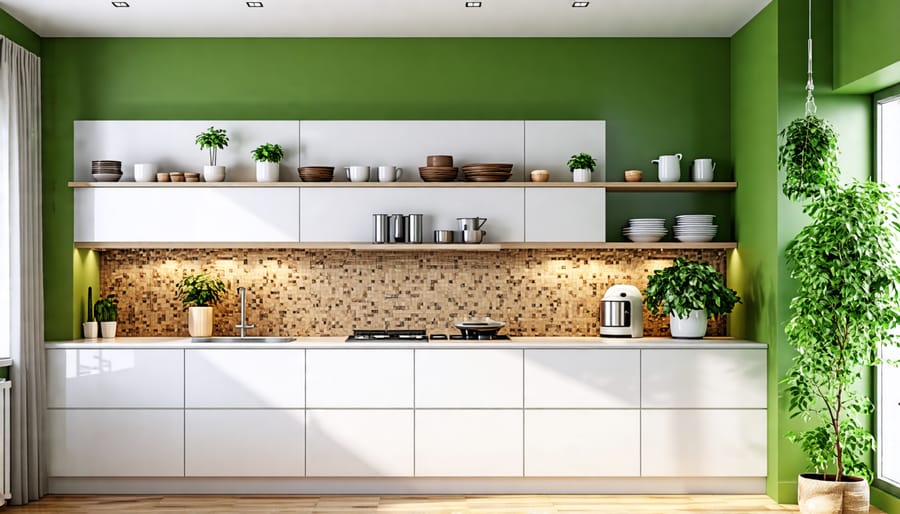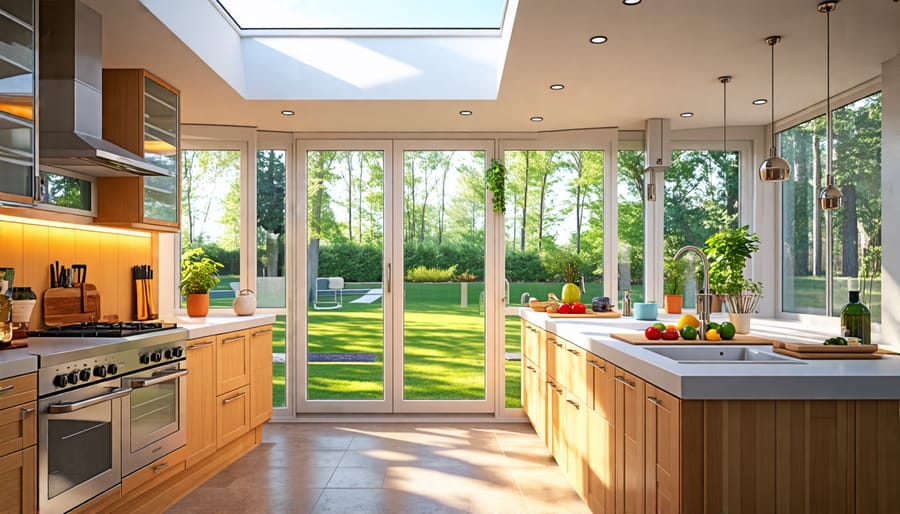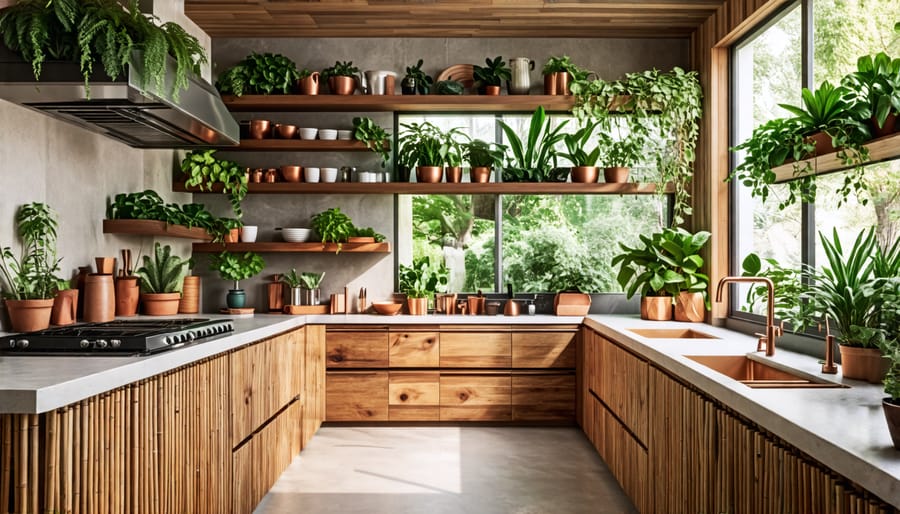Embrace the organic essence of nature in your kitchen with these design ideas that harmonize sustainability, functionality, and timeless beauty. Harness the innate warmth of natural materials like reclaimed wood, bamboo, and stone to craft countertops, shelving, and flooring that ground your space in earthy elegance. Bathe your kitchen in an uplifting palette of muted greens, warm terracottas, and creamy neutrals, punctuated by live edge accents and touches of coppery patina. Flood the heart of your home with an abundance of natural light, supplemented by energy-efficient fixtures that cast a soft, inviting glow. Enliven your organic haven with lush herbs, trailing vines, and vibrant veggies flourishing in wall-mounted planters, breathing vitality into your culinary rituals.
Embrace Natural Materials

Countertops
When selecting countertops for your organic kitchen, opt for materials that embody nature’s beauty and durability. Natural stone options like granite, marble, or soapstone bring an elegant, earthy aesthetic while offering superior resilience. For a warmer, rustic charm, consider butcher block wood countertops. Not only do they lend a cozy ambiance, but they also provide a practical surface for food preparation. If you’re seeking eco-friendly alternatives, explore composite countertops made from recycled materials or sustainable resources like bamboo or cork. These choices blend sustainability with style, ensuring your countertops reflect your commitment to both design and the environment.
Flooring
When choosing flooring for your organic kitchen, opt for natural materials that are both beautiful and sustainable. Hardwood is a classic choice that adds warmth and character, with options like reclaimed wood for an eco-friendly touch. Cork flooring is another great option, as it’s renewable, comfortable underfoot, and naturally resistant to moisture and bacteria. For a luxurious look, consider natural stone tiles like slate, travertine, or marble, which offer unique patterns and textures. Polished concrete is a modern and durable choice that can be stained or stamped to mimic natural materials while providing a seamless, easy-to-clean surface.
Cabinetry
For an organic kitchen, opt for cabinetry made from natural, sustainable materials. Reclaimed wood is an eco-friendly choice that adds warmth and character, with each piece telling a unique story. Bamboo is another excellent option, as it’s durable, fast-growing, and renewable. If you prefer a modern look, consider laminates with wood grain finishes that mimic the appearance of natural wood without the maintenance. These materials bring a touch of nature into your kitchen while promoting a more sustainable lifestyle. When selecting your cabinetry, look for low-VOC finishes and formaldehyde-free adhesives to ensure a healthy indoor environment.
Bring in Earthy Colors
Incorporating an earthy color palette is a key element of organic kitchen design. Opt for soothing shades of green, rich browns, soft grays, and creamy off-whites to create a natural, inviting atmosphere. These colors evoke a sense of serenity and connection to the outdoors.
For walls, consider a warm, light gray or a soft, sage green. These neutral tones provide a versatile backdrop for other elements in your kitchen. If you prefer a bolder look, a deep, forest green or a rich, earthy brown can make a stunning statement on an accent wall or as a backsplash.
When it comes to cabinets, natural wood finishes in warm tones like oak, walnut, or cherry are perfect for an organic feel. If you prefer painted cabinets, opt for a soothing off-white or a muted green for a fresh, natural look. For a more rustic vibe, consider a distressed paint finish in a soft gray or taupe.
Accents and accessories provide the perfect opportunity to incorporate pops of earthy colors. Think terracotta pottery, woven baskets in natural fibers, or a wooden cutting board in a rich, honey tone. Textiles like kitchen towels, oven mitts, and curtains in earthy shades of olive, rust, or mustard can add warmth and texture to your space.
Remember, the key to using earthy colors in your organic kitchen is to create a harmonious, balanced palette that feels natural and inviting. Experiment with different shades and textures to find the perfect combination that reflects your personal style and creates a warm, welcoming heart of your home.

Maximize Natural Light
Natural light is a key element in creating an organic kitchen that feels fresh, vibrant, and connected to the outdoors. Not only does it enhance the visual appeal of your space, but it also boosts your mood and reduces energy consumption. To maximize natural light in your kitchen, consider installing larger windows or even a skylight. This will flood your space with sunlight, making it feel more open and airy.
Another clever way to bring in more natural light is by using light shelves. These horizontal surfaces reflect sunlight deeper into the room, illuminating areas that might otherwise be dim. Glass-front cabinets are also a great choice for an organic kitchen. They allow light to pass through, creating a sense of depth and making your space feel larger.
When planning your layout, aim to position your kitchen workspaces near windows. This will ensure you have plenty of natural light while preparing meals and also provide a pleasant view of the outdoors. Remember, the more natural light you can bring into your organic kitchen, the more inviting and refreshing it will feel. So, embrace the power of sunlight and let it transform your cooking space into a bright, welcoming haven.

Incorporate Living Elements
Bringing the outdoors in is a key principle of organic kitchen design. One of the easiest and most impactful ways to achieve this is by adding plants to your kitchen space. Consider incorporating a variety of potted herbs like basil, mint, and rosemary, which not only look and smell great but can also be used in your cooking. For a more dramatic statement, create a living wall filled with lush greenery like ferns, philodendrons, or succulents. When selecting plants for your kitchen, opt for species that thrive in the specific light and humidity conditions of the room. Most herbs and leafy green plants prefer bright, indirect light, while succulents can tolerate more direct sun. Be sure to choose pots with proper drainage and water your plants regularly to keep them healthy and vibrant. With a little care and attention, living elements can transform your kitchen into a serene, nature-inspired oasis that promotes wellness and tranquility.
Choose Energy-Efficient Appliances
When designing an organic kitchen, selecting energy-efficient appliances is crucial for reducing your environmental impact and utility bills. Look for appliances with the Energy Star label, which indicates they meet strict energy efficiency guidelines. Opt for refrigerators with top-mounted freezers, as they consume 10-25% less energy than bottom-mounted or side-by-side models. Induction cooktops are another eco-friendly choice, as they heat food more efficiently than traditional electric or gas ranges. When replacing your dishwasher, choose a model with a high Energy Star rating and features like soil sensors and efficient jet technology to minimize water usage. Energy-efficient appliances may have a higher upfront cost, but their long-term savings and environmental benefits make them a worthwhile investment for your organic kitchen. By making informed choices, you can create a beautiful, sustainable space that aligns with your values and promotes a healthier planet.
Accessorize Organically
When it comes to adding the finishing touches to your organic kitchen, think beyond store-bought decor. Instead, embrace the beauty of natural fabrics, handmade items, and reclaimed objects. Drape your windows with breezy linen curtains or hang a rustic, hand-woven tapestry on the wall for added texture. Display your favorite handcrafted pottery pieces on open shelves, showcasing their unique imperfections. Scour flea markets and antique shops for vintage wooden bowls, cutting boards, or utensils that tell a story. Repurpose old jars as vases for fresh flowers or as containers for storing dry goods. By incorporating these one-of-a-kind elements, you’ll create a space that feels authentic and personalized. Remember, the key to organic design is embracing the perfectly imperfect nature of handmade and reclaimed items. Let your accessories reflect your values and add a touch of warmth to your kitchen. Whether it’s a hand-stitched tea towel, a set of mismatched ceramic mugs, or a well-loved wooden stool, these organic accents will make your kitchen feel like a true extension of your home and your heart.
Conclusion
Incorporating organic elements into your kitchen design offers numerous benefits, from creating a calming and inviting atmosphere to promoting sustainability and wellbeing. By embracing natural materials, soothing colors, and lush plants, you can transform your kitchen into a serene and eco-friendly space that reflects your personal style. Remember, even small changes can make a significant impact, so start by introducing a few organic elements and gradually build upon them over time. Whether you opt for a reclaimed wood dining table, install energy-efficient appliances, or add a herb garden on your windowsill, each step brings you closer to achieving a beautiful, organic kitchen that nurtures both your body and soul.





